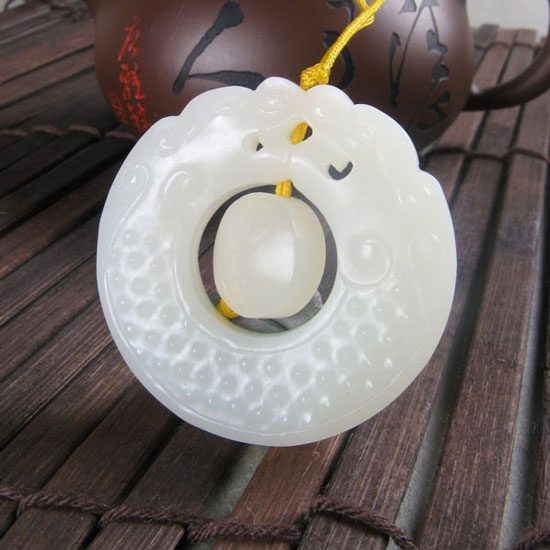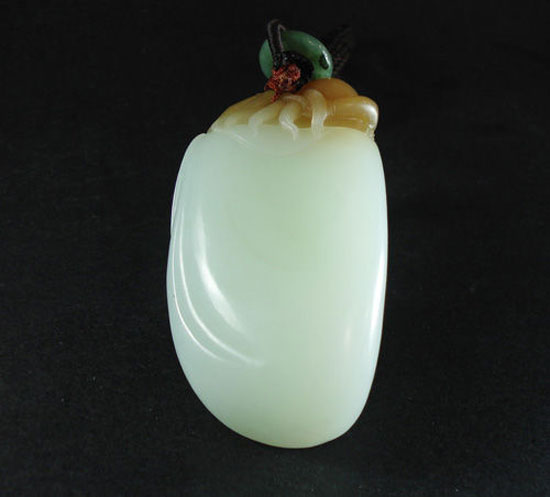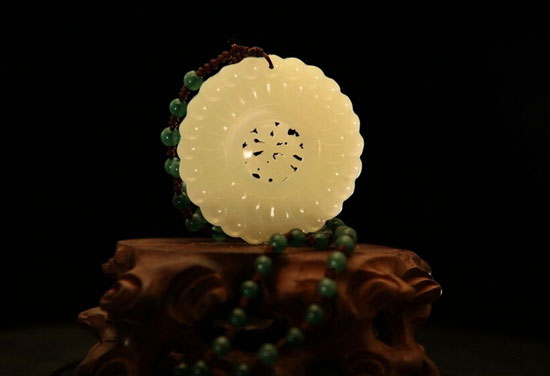As a representative jade material of Chinese jade, nephrite records the traditional Chinese jade culture and plays a pivotal role in ancient Chinese jade. Taking advantage of the tradition of ancient jade, combined with modern craftsmanship, on the basis of reflecting the beauty of jade, paying attention to the elegance and style of the style, this jade ware in Chinese oriental art is more open and more beautiful. China is a country with a long history and splendid civilization. With its 7,000-year history, Chinese jade has become one of the important symbols of ancient Chinese culture, like Chinese porcelain and silk. It is known as the oriental art and enjoys the world. High reputation. The development and utilization of Hetian jade in China has a long history and a long history. The jade made of Hetian jade has a strong Chinese character and distinctive national characteristics. It is a precious heritage and artistic treasure in the treasure house of Chinese national culture. 1. Hetian jade is the main jade material of Chinese ancient jade (1) The Neolithic Age is characterized by the use of inland or even local colored stone as jade raw materials, mainly represented by the red mountain culture in the north, the Liangzhu culture in the south, and the Beinan culture in Taiwan. The main jade materials are quartzite and silicon. Rock, tremolite, serpentine and so on. (2) From the late Shang Dynasty to the Warring States Period, the colored stones of Hetian jade and domestic real estate produced in Xinjiang coexisted, and the number of Hetian jade gradually increased. At the latest in the Shang Dynasty, the use of jade material has undergone major changes. According to the identification of jade articles unearthed from the Yinyang Women’s Tomb in Anyang and the Xingan Shang Dynasty Tomb in Jiangxi, a considerable part of the jade has come from Xinjiang Hetian. From the Han Wu Emperor sent Zhang Huan to the Western Regions for a thousand years, more than 3,000 years ago, the jade was transported from Xinjiang to the mainland. Some scholars speculated that there was already a Xinjiang-inland area before the Silk Road opened to the west. The jade road that transports jade. (3) From the Han Dynasty to the Ming Dynasty, the jade material was dominated by Hetian jade. In the middle of the Western Han Dynasty, the traffic between the Central Plains Dynasty and the Western Region was unimpeded, and Hetian Yuyuan continued to transport into the mainland. Among the various jade materials, Hetian jade's texture and color are unmatched by other colored stones. Therefore, since Hetian jade entered the mainland, not only has the color stone been gradually squeezed out, but also in the various jade. Many jade artifacts unearthed in the tombs of the princes of the Han Dynasty, such as the tomb of Liu Sheng in Mancheng, Hebei, and the tomb of Huainan in Anhui, were identified as Hetian jade. The folk jade is mostly Dushan jade and jade. From the comparison of the production of several large jade materials after Qin and Han Dynasties, Hetian jade is the best in terms of quality, followed by Dushan jade; in terms of output, the situation is just the opposite, and Hetian jade is the least, which is also the reason for its preciousness. (4) Hetian Yu in the Qing Dynasty occupied a monopoly position. Until the end of the Qing Dynasty, there was a large influx of jade, and Hetian Yu gradually became less and less. The ethos of Hezhong and Tianyu continued until the Qing Dynasty. In particular, the Emperor Qianlong did not hesitate to purchase Hetian jade from Xinjiang to produce jade articles in the interior. For example, the Yushanzi, which is now in the Forbidden City, is the "Dazhi Water Map" from Xinjiang. Jade treasures shipped to Yangzhou for transport and returned to Beijing. At present, Hetian jade is still an important raw material for modern jade, and high-quality white jade material is still in short supply. At present, the development of Hetian jade is organized and planned under the leadership of the state. Xinjiang has established a jade-management organization, and jade mines have been established in Tian, ​​Qiemo, Manas and other places, and jade purchase stations have been set up in Hotan, Kashi, and Qiemo, which has expanded the production of Hetian jade. 2. The jade that uses Hetian jade as the jade material is the main carrier of jade culture. Jade articles have been accompanied by the Chinese nation for at least 7,000 years of history. In this long period of time, jade is a rare artifact with such a strong vitality. It is different from many other artifacts in history, such as the pottery and stone tools of the Neolithic Age, the bronzes of the Shang and Zhou Dynasties, and the Wei and Jin Dynasties. Porcelain, etc., have withdrawn from the historical arena due to the decline of human progress and cultural changes, which have gradually declined or been replaced by other things. Chinese people have a special preference for jade. Many people have never touched jade. The first time they saw jade, regardless of the quality of this jade, it will produce a special emotion from the depths of the heart. Jade can be different cultures, The acceptance of people of different nationalities and different periods shows its charm. (1) When the political value jade appeared, it was only used as a production tool and original ornament. With the development of production, the polarization between the rich and the poor has led to the emergence of the class and the emergence of the state, and the concept of hierarchy has also emerged. Slowly, this kind of production is rare, and the beautiful and durable jade has become a special object enjoyed by the ruling class. And given a special meaning. As a norm of political hierarchy, in the Spring and Autumn Period and the Warring States period, jade articles have detailed records. For example, the use of "Six Rui" is as follows: Wang Zhizhen Gui, Gong Zhiyu, Hou Zhixin, Bo Zhiqi, Zizhigu Hey, the man is holding a puppet. These specifications are distinguished by the shape and size of the jade. The town is the largest, followed by Guigui, and the baron with the lowest position of Xingui is the jade-shaped jade with the pattern. After Qin, Yuxi became a symbol of monarchy. The system of jade-like shackles has always followed the Qing Dynasty, and the Emperor Qianlong of the Qianlong Emperor, mostly made of jade. Yu Yu is so, jade belt also has a level regulation, the Tang Dynasty clearly stipulated the system of officials using jade belt. "New Tang Book · Car Service" contains "the service of purple as the three products, the golden jade with the thirteen; the service of the four products, the gold belt 挎 eleven; the shallow 绯 is the clothing of the five products, the gold belt 挎eleven". It can be seen that from the end of the primitive society to the Qing Dynasty, some jade articles have always been an important symbol of the political hierarchy. (2) When morality is given to jade culture, jade is endowed with morality. The so-called "gentleman is better than jade, gentleman is jade" is the personification of jade. The moral connotation of jade has been produced in the early Western Zhou Dynasty. Since then, a set of jade morality has been developed, and its conception and systemization have been carried out. After Confucius founded the Confucian doctrine, the Confucian use of jade has been running through the whole. Chinese feudal society is deeply rooted in people's minds. Confucian morality is known for its coverage of benevolence, righteousness, courtesy, wisdom, and faith. Jade morality is based on it, symbolizing the noble character and sentiment in ethical concepts. Among them, there are many words that the ancient working people created to relate to jade, which means more beautiful and noble. For example, people often use "nearly jade, not for the whole" to compare someone's noble sentiment and arrogance. The Chinese nation's preference, propaganda, and respect for jade have been tenaciously vitalized by the thinkers and have been used by ruling classes of all ages. The morality and personification of jade are widely accepted by the people and are an important reason for the longevity of jade. (3) Economic value The economic value of jade is self-evident. As a symbol of wealth, jade has been expressed in the Liangzhu culture and Hongshan culture of the primitive society. In the large tombs, there are dozens or even hundreds of jade articles as funerary burials. It can be seen that the tomb owner is the leader with powerful and wealthy wealth. In the slave society, this phenomenon is more obvious. The famous Anyang Yinxu Women's Tomb, Jiangxi Xingan Tomb and other Shang Dynasty aristocrats and Fangguo tombs are rich in burial jade, indicating that the large slave owners have valuable jade articles. In the Han Dynasty, the wind of the funeral jade was more prosperous. The famous Han Dynasty Jin Yu Yu Yi, Yin Yu Yu Yi, and Tong Yu Yu Yi came from this. In addition, the most valuable indicator of the economic value of jade is the jade coin of the Shang Dynasty. It is made of jade as a beetle, as a voucher for the exchange of goods, and also a gift for direct exchange or tribute of jade. After the Ming and Qing Dynasties, jade goods became an industry and traded. (4) Etiquette function etiquette has always occupied the mainstream of Chinese jade. Since the late Neolithic period, many jade articles such as ç®, ç’œ, ç’§, etc. have been used as etiquette devices. As early as 5,000 years ago, when China first entered the threshold of civilization, the etiquette function of jade was revealed. The jade of Liangzhu culture, the human face jade shovel of Longshan culture, and the gums of Erlitou culture are pure ceremonial devices. In the later days, some jade weapons were also used as instruments. The famous "Six Rui" is not only a symbol of the political hierarchy, but also a concrete manifestation of the ritual system. "In the sky, to the heavens, to the Yellow Emperor, to the Qing Dynasty, to the south, to the south, to the south, to the west, to the north," Six instruments. Liurui and Liuzong are the backbones of feudal jade in feudal society. Until the Yuan Dynasty, when the Royal Palace held a ceremony of sacrifice, it also used Guiqi, Huangpi, Qinggui, Akasaka, Baihu, Xuanzang, and the rituals of the Ming Dynasty emperor's tombs were also unearthed in the Ming Tombs. In the spring and autumn swearing ruins of Houma, Shanxi, a large number of utensils such as Gui and ç’œ were discovered, which should be the rituals used in the alliance ceremony. (5) Adornment and play is one of the original functions of jade, and it is also the most widely used jade. "The ancient gentleman will wear jade", "the gentleman has no reason, the jade does not go to the body." In ancient times, it was not a simple decoration. It also showed identity and ethos, and it could play a role in emotional and linguistic communication. From the Neolithic Age, the new music culture in the northeast, the Ligang culture in North China, and the Hemudu culture in the south of the Yangtze River have found jade ornaments, such as rings and pendants. More than 700 pieces of jade unearthed from the tomb of the King Wuding spouse of the Shang Dynasty, quite a part of the perforated jade used for the decoration. In the Spring and Autumn Period, the gentleman Pei Yu, the young woman wearing the jade wind is very popular, young men and women also give each other as a token. Peiyu has become a social fashion that has lasted for thousands of years. After the Sui and Tang Dynasties, the jade as a decorative piece has undergone major changes in the variety, mainly as ears, wrists, hands and headwear. As a jade piece for viewing playthings, there have been many since the Shang and Zhou Dynasties. After the Tang and Song Dynasties, as a display of jade ornaments, such as antique jade rituals, bottles, stoves, pots, mountains, figures, animals, etc., occupy the main position of jade. Charger Plate,Custom Black Charger Plates,Portable Black Charger Plates,Creative Black Charger Plates shaoxing qinzi business company ltd , https://www.qinzisx.com

